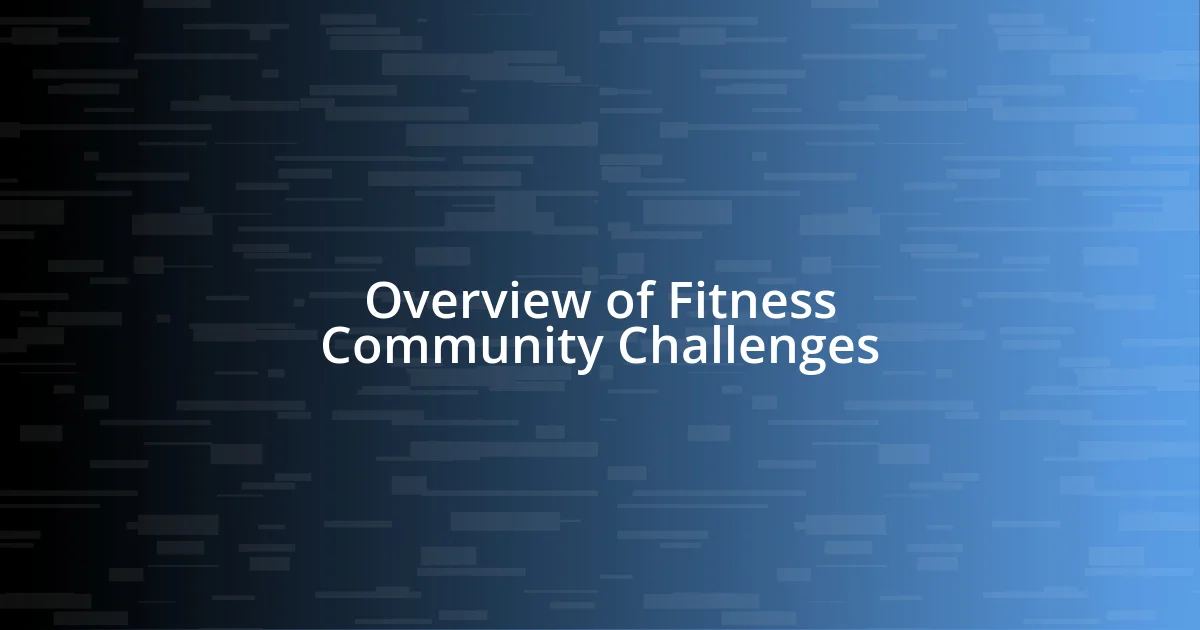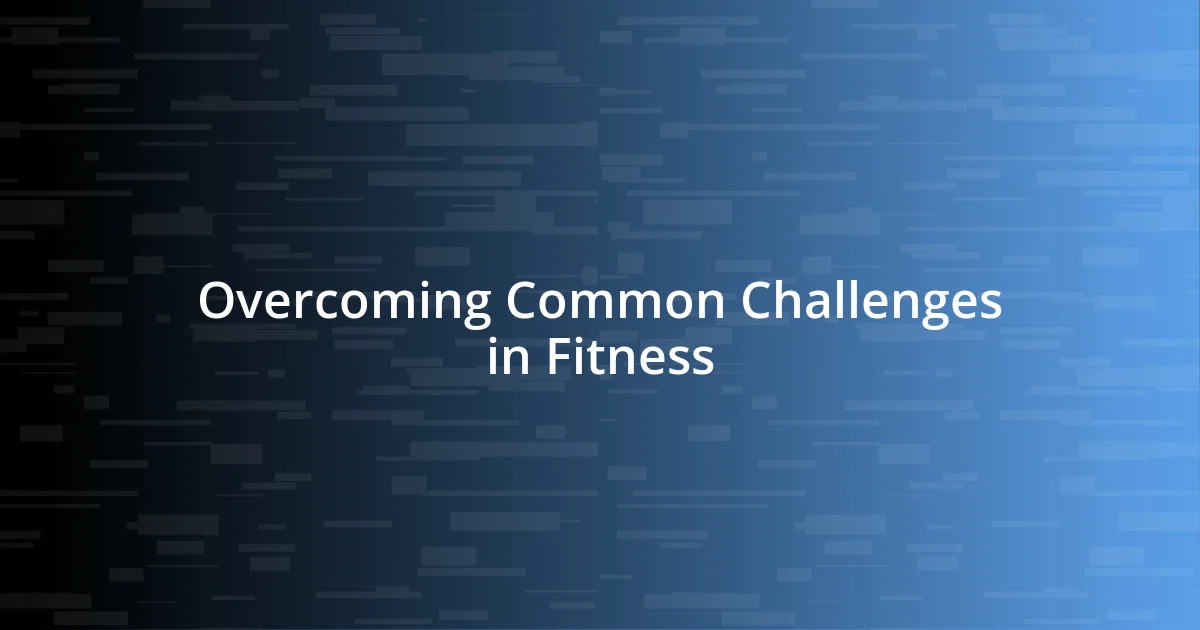Key takeaways:
- Fitness community challenges enhance motivation and accountability, turning individual efforts into shared victories.
- Participants benefit from skill development and form lasting friendships, enriching their fitness journeys beyond just physical gains.
- Engagement and sharing results within the community foster deeper connections, making challenges more enjoyable and supportive.

Overview of Fitness Community Challenges
Fitness community challenges, to me, are more than just competitions; they embody a collective spirit that drives individuals to push their limits. I remember participating in a month-long step challenge, seamlessly integrating friendly rivalry and shared goals with everyone in my group. This experience highlighted how synchronized efforts can make each accomplishment feel like a shared victory, turning personal goals into communal celebrations.
What really fascinates me about these challenges is the diversity of goals and backgrounds among participants. Imagine a seasoned athlete alongside a beginner; both striving for their personal best yet supporting each other along the way. Have you ever felt the thrill of encouragement when a community rallies around you? It’s not just about the physical transformation; it’s about creating a supportive environment where every small progress feels monumental.
These community challenges often foster a sense of accountability that’s hard to replicate in solo routines. I recall feeling more responsible for my own fitness journey because I knew others were counting on me. It made me wonder: how might our individual paths change if we embraced shared commitments more frequently? Engaging in these challenges has taught me that we all have unique stories that contribute to the overall narrative of health and wellness, making the journey far more enriching.

Benefits of Joining Fitness Challenges
Participating in fitness challenges offers an incredible boost in motivation that’s often hard to achieve alone. I distinctly recall a 30-day yoga challenge I joined. Every day, as I shared my progress with the group, the excitement and encouragement from my peers kept me motivated to roll out my mat, even on tough days. Those small daily check-ins felt like a gentle push, reminding me that I wasn’t in this alone. Have you ever found that extra spark from a community that compels you to stick to your goals? It’s truly a game changer.
Another benefit that has profoundly impacted me is the opportunity for skill development. I remember joining a cycling challenge and, despite being nervous about my skills, I discovered techniques and strategies that I had never considered before. The shared knowledge among participants opened my eyes to new approaches, improving not only my performance but my overall enjoyment of the ride. Isn’t it fascinating how much we can learn from each other in these group settings? It’s a testament to the diverse pool of experiences we draw from within the community.
Lastly, the friendships formed through these challenges can be immensely fulfilling. I think back to a running challenge where I connected deeply with a fellow participant; we shared our successes, setbacks, and even training tips. This camaraderie transformed our individual journeys into a shared adventure, creating bonds that extended beyond just fitness. How exciting is it to find people who can relate to your struggles and triumphs? These connections often turn into lasting friendships that motivate us long after the challenge is over.
| Benefit | Description |
|---|---|
| Motivation | Staying committed through shared goals and accountability. |
| Skill Development | Discovering new techniques and strategies from diverse participants. |
| Friendship | Forming lasting connections through shared experiences and struggles. |

Types of Fitness Community Challenges
Community challenges in fitness come in many shapes and forms, each designed to cater to varying interests and fitness levels. I clearly remember my experience with a nutrition challenge that encouraged participants to try new healthy recipes every week. Sharing photos and feedback with the group not only widened my culinary repertoire but also sparked lively discussions that turned the challenge into a delightful experience. This type of challenge is about more than just movement; it encompasses nutrition and overall wellness, which feels complementary to physical fitness.
Here are some common types of fitness community challenges I’ve encountered:
- Step Challenges: Competing to see who can take the most steps in a week or month, often tracked through apps.
- Workout-a-Day Challenges: Committing to a different workout every day for a set period, which keeps things fresh and exciting.
- Nutrition Challenges: Focusing on healthy eating habits, like trying a new recipe or tracking meals for accountability.
- Virtual Races: Participants complete a set distance (like a 5K) within a certain timeframe, often sharing their results on social media.
- Mindfulness Challenges: Incorporating practices like meditation or yoga into daily routines to enhance mental well-being.
Another fascinating type of challenge I participated in was a monthly fitness bingo. Each space on the bingo card was filled with various activities, from doing a certain number of push-ups to trying a new workout class. I can still recall the thrill of crossing off each completed task and racing against others in the group to complete my bingo card first. This playful approach made it a fun way to diversify workouts, and the sense of gamification transformed my usual routine into something exhilarating. The friendly competition added a layer of enjoyment that made fitness feel less like a chore and more like a joyful endeavor.

Popular Platforms for Fitness Challenges
When it comes to popular platforms for fitness challenges, I’ve found social media to be a vibrant space where these initiatives thrive. For instance, I often turn to Instagram and Facebook groups, where dedicated communities share challenges, photos, and progress updates. The visual aspect is powerful—seeing others tackle their fitness goals inspires me to step up my game. Have you ever scrolled through a hashtag and felt that surge of motivation just from witnessing others’ journeys?
Another noteworthy platform is dedicated fitness apps, such as MyFitnessPal or Strava, which help track workouts and foster friendly competition. I remember using Strava during a cycling challenge; it was exhilarating to see my rides compared to friends’, pushing me to keep up the pace. These apps not only record our achievements but also create accountability through leaderboards and challenges. Doesn’t it feel good to know that there’s a community cheering you on while you log those miles?
Lastly, I can’t overlook the value of local gyms and community centers that host their own fitness challenges. A few years back, I joined a community bootcamp, where we engaged in month-long challenges. The camaraderie in those sessions was infectious; we cheered each other on during our grueling workouts, pushing our limits together. How else would we build that sense of togetherness and motivation, if not through a physical space where everyone’s sweating it out side by side?

Strategies for Success in Challenges
Staying focused on the goals is crucial in any fitness challenge. I remember during a month-long plank challenge, setting mini-goals helped me push through the tougher days. When I aimed to improve my time by mere seconds each week, it felt less overwhelming and way more rewarding. Have you ever broken down a sizable goal into smaller, manageable pieces? It truly makes the journey feel achievable!
Engagement with others is a game-changer. When I took part in a running challenge, our group’s shared progress transformed the experience from solitary runs to collaborative victories. I found myself craving feedback and encouragement; it built a sense of accountability that I didn’t expect. How do you think connecting with others impacts your own motivation? For me, it turned support into a powerful driving force to keep going even when my legs were weary.
Lastly, flexibility is key. In one of my challenges, I allowed myself to modify workouts based on my energy levels, and it made all the difference. There’s a certain liberation in understanding that progress doesn’t require perfection. This mindset shift helped me to embrace each setback as a learning opportunity rather than a failure. Have you ever felt stuck because you were trying to stick rigidly to a plan? By being adaptable, I found joy in the journey, ensuring that fitness became a celebrated part of my life rather than a source of stress.

Overcoming Common Challenges in Fitness
I’ve encountered various challenges in fitness that often feel like roadblocks on my journey. Take, for instance, the times I felt utterly demotivated after experiencing a setback, like missing a workout or not seeing results. What I’ve learned is that these moments are opportunities for reflection. They remind me to reassess my approach—whether it’s modifying my routine or simply giving myself the grace to restart. Isn’t it freeing to realize that stumbling doesn’t spell failure; it’s part of the path?
Another challenge I’ve faced is the overwhelming pressure to keep up with others in group settings. During a particularly intense sprint challenge, I initially felt intimidated by the speed of the other participants. But rather than compare myself, I shifted my focus inward—setting my own pace and honoring where I was in my fitness journey. This experience taught me that personal progress should be the defining metric rather than external comparisons. Have you ever found yourself in a similar situation, and how did you handle it?
Lastly, I often struggle with maintaining motivation, especially as life gets busier. I vividly recall a time when my schedule felt too hectic to fit in my usual workouts. I decided to get innovative—turning everyday activities, like walking my dog, into mini-challenges. Suddenly, my regular routine became infused with playfulness rather than stress. Isn’t it amazing how we can recast our views on fitness by integrating it into our daily lives? Using creativity in this way has made fitness feel more sustainable for me, allowing joy to take precedence over perfection.

Sharing Results and Building Community
Sharing results within a fitness challenge fosters a profound sense of community. I distinctly remember the excitement that washed over me when I posted my progress after a month-long fitness challenge. The influx of supportive comments from fellow participants made my achievements feel significantly more valued. Have you ever experienced that rush of motivation from someone else’s encouragement? It’s incredible how a simple “Well done!” can ignite a fire within you to push even harder.
Creating a space where everyone shares their victories—big or small—bridges the gap between individual journeys. During a team fitness event, we had a dedicated post where everyone could share before-and-after photos. The vulnerability of showing our progress, along with the triumphs of others, built an unspoken bond between us. It felt like we were all in the same boat, celebrating milestones together. I often ask myself, how can we nurture such openness and trust in our communities? I believe that cultivating a judgment-free atmosphere encourages stronger connections and boosts our collective spirit.
Moreover, the shared experience of struggles can also strengthen community ties. One evening, after a particularly grueling workout, we gathered over video chat. Listening to each person share their toughest moments made me realize we were all facing comparable challenges. It felt comforting to know I wasn’t alone on the tougher days. What if we leaned more into those shared struggles? By expressing our authentic experiences, we open doors for deeper connections, transforming our fitness journey into a collective adventure rather than a solitary path.














